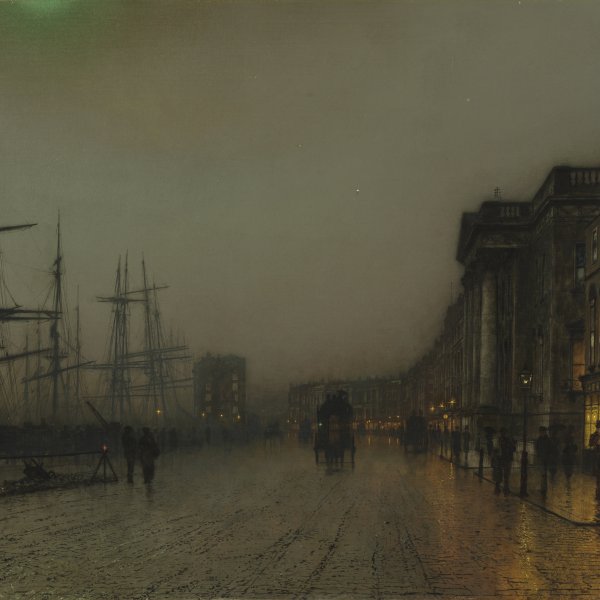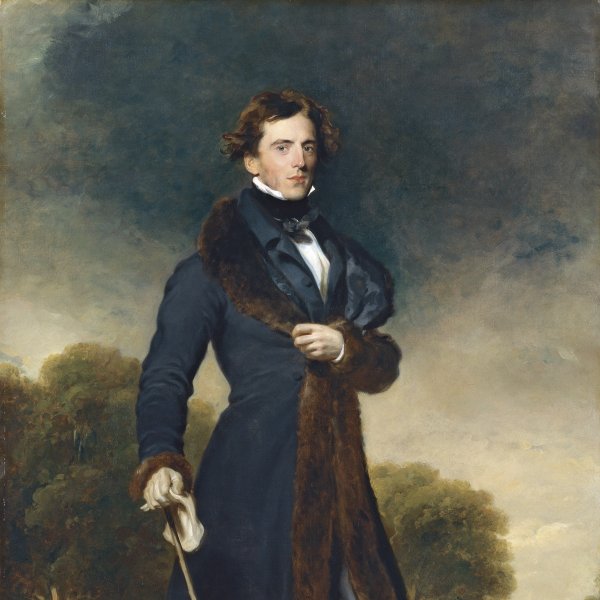A Moonlit Evening
1880
Oil on Cardboard.
25.5 x 46 cm
Carmen Thyssen Collection
Inv. no. (
CTB.1990.11
)
Not on display
Level 2
Permanent Collection
Level 1
Permanent Collection
Level 0
Carmen Thyssen Collection and Temporary exhibition rooms
Level -1
Temporary exhibition rooms, Conference room and EducaThyssen workshop
When John Atkinson Grimshaw married his wife, Theodosia Hubbard, they lived in a very small house in Leeds, and although he longed to paint, they had insufficient money to allow him to give up his job working on the railways. In the evenings, he enjoyed going for walks with his wife through the darkened streets and woodlands of the Leeds suburbs, and then inspired by this he would go home and paint. These records of moonlit walks now constitute the essence of Grimshaw's popularity and reputation as a painter. By 1861, he was successful enough as an artist to give up his daytime job and devote his career entirely to painting.
John Atkinson Grimshaw loved to paint the vast mansions of 19th-century England, he delighted in the romance and the elegance of their architecture, and his pleasure in them was satisfied when, in 1870, he moved into a Jacobean house, Knostrop Old Hall, which became the family home. He was fascinated by the contrast between moonlight and artificial light and in his urban scenes, he experiments with the varied effects of the moon, the light glowing from inside houses, and the reflections of moonlight on the wet road.
During the 19th-century, the English northern cities expanded with industrialisation, and new leafy suburbs developed as the wealthy industrialists began to build their own private homes, sheltered from the street by high-walls and tall trees. The home was of paramount importance to Victorian society, as it was seen as a haven of family values, shelter and security. Grimshaw himself believed in the sanctity of marriage and family, and, despite financial hardships, enjoyed a secure relationship with his wife and was a loving father to their children. His moonlight scenes were made more appealing for their aesthetic embellishment of the Industrial Revolution era, the deserted streets bore no relation to the environment within the labour-intensive factories.
A Moonlit Evening is a wonderful example of the unique genre which Grimshaw created. Grimshaw specialised in the depiction of moonlit walks, shadowed streets and rain-washed roads, to make atmospheric compositions which were highly individual to the artist. The house in this painting is probably fictitious, to the artist's own design, based on a combination of styles which he observed and absorbed. He often included a solitary figure which added a sense of contemplation and ambiguity to the scene, inviting the viewer to imagine a narrative for the scene, to consider the thoughts and feelings of the person, and to dwell on their walk on a lost and lonely night. It implies both a sense of isolation, but simultaneously of freedom, in the abandonment of conventions for a single female to be wandering alone in the dark, accompanied only by her thoughts, and this is an appealing romantic notion, probably inspired by Grimshaw's love of Lord Alfred Tennyson's yearning poetry.
Nicole Ayton
John Atkinson Grimshaw loved to paint the vast mansions of 19th-century England, he delighted in the romance and the elegance of their architecture, and his pleasure in them was satisfied when, in 1870, he moved into a Jacobean house, Knostrop Old Hall, which became the family home. He was fascinated by the contrast between moonlight and artificial light and in his urban scenes, he experiments with the varied effects of the moon, the light glowing from inside houses, and the reflections of moonlight on the wet road.
During the 19th-century, the English northern cities expanded with industrialisation, and new leafy suburbs developed as the wealthy industrialists began to build their own private homes, sheltered from the street by high-walls and tall trees. The home was of paramount importance to Victorian society, as it was seen as a haven of family values, shelter and security. Grimshaw himself believed in the sanctity of marriage and family, and, despite financial hardships, enjoyed a secure relationship with his wife and was a loving father to their children. His moonlight scenes were made more appealing for their aesthetic embellishment of the Industrial Revolution era, the deserted streets bore no relation to the environment within the labour-intensive factories.
A Moonlit Evening is a wonderful example of the unique genre which Grimshaw created. Grimshaw specialised in the depiction of moonlit walks, shadowed streets and rain-washed roads, to make atmospheric compositions which were highly individual to the artist. The house in this painting is probably fictitious, to the artist's own design, based on a combination of styles which he observed and absorbed. He often included a solitary figure which added a sense of contemplation and ambiguity to the scene, inviting the viewer to imagine a narrative for the scene, to consider the thoughts and feelings of the person, and to dwell on their walk on a lost and lonely night. It implies both a sense of isolation, but simultaneously of freedom, in the abandonment of conventions for a single female to be wandering alone in the dark, accompanied only by her thoughts, and this is an appealing romantic notion, probably inspired by Grimshaw's love of Lord Alfred Tennyson's yearning poetry.
Nicole Ayton








